Friedrich Wilhelm von Steuben
Friedrich Wilhelm August Heinrich Ferdinand von Steuben (born Friedrich Wilhelm Ludolf Gerhard Augustin von Steuben; September 17, 1730 – November 28, 1794), also referred to as Baron von Steuben (German: [fɔn ˈʃtɔʏbn̩]), was a Prussian and later an American military officer. He served as Inspector General and a Major General of the Continental Army during the American Revolutionary War. He was one of the fathers of the Continental Army in teaching them the essentials of military drills, tactics, and discipline.[1] He wrote Regulations for the Order and Discipline of the Troops of the United States, the book that served as the Army's drill manual for decades. He served as General George Washington's chief of staff in the final years of the war.[2]
Baron von Steuben | |
|---|---|
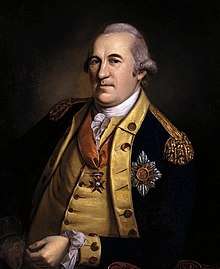 Friedrich Wilhelm von Steuben, by Charles Willson Peale | |
| Birth name | Friedrich Wilhelm August Heinrich Ferdinand von Steuben |
| Born | September 17, 1730 Magdeburg, Duchy of Magdeburg, Kingdom of Prussia, Holy Roman Empire |
| Died | November 28, 1794 (aged 64) Steuben, New York, United States |
| Buried | Steuben Memorial State Historic Site, Remsen, New York, United States |
| Allegiance | |
| Service/ | |
| Years of service | 1744–1762 1778–1783 |
| Rank | |
| Battles/wars | War of 1744
|
| Awards | Cross of the Order of De la Fidelite |
| Signature | |
Early life and education
Baron von Steuben was born in the fortress town of Magdeburg, Germany, on September 17, 1730, the son of Royal Prussian Engineer Capt. Baron Wilhelm von Steuben and his wife, Elizabeth von Jagvodin.[3] When his father entered the service of Empress Anna of Russia, young Friedrich went with him to Crimea and then to Kronstadt, staying until the Russian war against the Turks under General Burkhard Christoph von Münnich. In 1740, Steuben's father returned to Prussia and Friedrich was educated in the garrison towns Neisse and Breslau by Jesuits. Despite his education by a Catholic order, von Steuben remained critical of Roman Catholicism.[4]:63 Originally, von Steuben's family were Protestants in the Kingdom of Prussia, and after his emigration to America he became a member of the Reformed German Church, a Reformed congregation in New York.[5] It is said that at age 14 he served as a volunteer with his father in one of the campaigns of the War of the Austrian Succession.[6]
First military service
Baron von Steuben joined the Prussian Army at age 17.[7] He served as a second lieutenant during the Seven Years' War in 1756, and was wounded at the 1757 Battle of Prague.[7] He served as adjutant to the free battalion of General Johann von Mayr and was promoted to first lieutenant in 1759.[7] In August 1759 he was wounded a second time at the Battle of Kunersdorf.[7] In the same year, he was appointed deputy quartermaster at the general headquarters. In 1761 he became adjutant of the Major General Von Knobloch upon being taken prisoner by the Russians at Treptow.[7] He subsequently attained the rank of captain, and served as aide-de-camp to Frederick the Great; in 1762 he was one of 13 young officers chosen to participate in a special course of instruction delivered by the king himself.[8]
Upon the reduction of the army at the end of the war, in 1763, Steuben was one of many officers who found themselves unemployed.[8] Towards the end of his life, Steuben indicated in a letter that "an inconsiderate step and an implacable personal enemy" led to his leaving the Prussian army.[4]:61
Service in Hohenzollern-Hechingen
In 1764 Steuben became Hofmarschall to Fürst Josef Friedrich Wilhelm of Hohenzollern-Hechingen, a post he held until 1777.[9] In 1769 the Duchess of Wurttemberg, niece of Frederick the Great, presented him with the Cross of the Order of De la Fidelite.[10] In 1771 he began to use the title baron. That same year he accompanied the prince to France, hoping to borrow money. Failing to find funds, they returned to Germany in 1775, deeply in debt.[8]
In 1763 Steuben had been formally introduced to the future French Minister of War, Claude Louis, Comte de Saint-Germain, in Hamburg. They met again in Paris in 1777. The Count, fully realizing the potential of an officer with Prussian general staff training, introduced him to Benjamin Franklin. Franklin, however, was unable to offer Steuben a rank or pay in the American army. The Continental Congress had grown tired of foreign mercenaries coming to America and demanding a high rank and pay. Promoting these men over qualified American officers caused discontent in the ranks. Von Steuben would have to go to America strictly as a volunteer, and present himself to Congress. Steuben left these first meetings in disgust and returned to Prussia.[7] Steuben found waiting for him allegations that he engaged in homosexual relationships with young men while in the service of Prince Josef Friedrich Wilhelm of Hohenzollern-Hechingen. The allegations were never proven, but Steuben knew they would stymie his chances at an officer's position in Europe.[11] Threatened with prosecution for his alleged homosexuality, Steuben returned to Paris.[12] Rumors followed him from Prussia to America that he was homosexual, but there never was an investigation of von Steuben and he received a congressional pension after the war.[13]
Upon the Count's recommendation, Steuben was introduced to future president George Washington by means of a letter from Franklin as a "Lieutenant General in the King of Prussia's service", an exaggeration of his actual credentials that appears to be based on a mistranslation of his service record. He was advanced travel funds and left Europe from Marseilles on Friday, September 26, 1777, on board the frigate Flamand.[9]
American Revolution
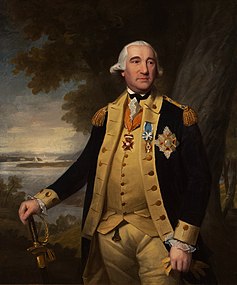
The Baron, his Italian Greyhound Azor (which he took with him everywhere), his young aide-de-camp Louis de Pontière, his military secretary, Peter Stephen Du Ponceau (then called Pierre Etienne Du Ponceau), and two other companions, reached Portsmouth, New Hampshire, on December 1, 1777, where they were almost arrested for being British because Steuben had mistakenly outfitted them in red uniforms.[7] They were extravagantly entertained in Boston. On February 5, 1778, Steuben and his party arrived in York, Pennsylvania, where the Continental Congress had relocated after being ousted from Philadelphia by the British advance. Arrangements were made for Steuben to be paid following the successful completion of the war according to his contributions. He arrived at Valley Forge on February 23, 1778, and reported for duty as a volunteer. One soldier's first impression of the Baron was "of the ancient fabled God of War ... he seemed to me a perfect personification of Mars. The trappings of his horse, the enormous holsters of his pistols, his large size, and his strikingly martial aspect, all seemed to favor the idea. He turned the volunteers into a great army."[7]
Inspector General
Washington appointed von Steuben as temporary inspector general. He went out into the camp to talk with the officers and men, inspect their huts, and scrutinize their equipment. Steuben established standards of sanitation and camp layouts that would still be standard a century and a half later. There had previously been no set arrangement of tents and huts. Men relieved themselves where they wished, and when an animal died it was stripped of its meat and the rest was left to rot where it lay. Steuben laid out a plan to have rows for command, officers, and enlisted men. Kitchens and latrines were on opposite sides of the camp, with latrines on the downhill side. There was the familiar arrangement of company and regimental streets.
On May 5, 1778, on General Washington's recommendation, Congress appointed Steuben inspector general of the army, with the rank and pay of major general. The internal administration had been neglected, and no books had been kept either as to supplies, clothing, or men. Steuben became aware of the "administrative incompetence, graft, war profiteering" that existed.[14] He enforced the keeping of exact records and strict inspections. His inspections saved the army an estimated loss of five to eight thousand muskets.[10]
Training program
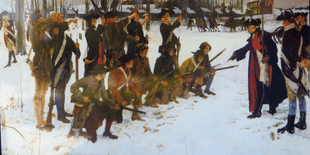
Steuben picked 120 men from various regiments to form an honor guard for General Washington, and used them to demonstrate military training to the rest of the troops.[10] These men in turn trained other personnel at regimental and brigade levels. Steuben's eccentric personality greatly enhanced his mystique. In full military dress uniform, he twice a day trained the soldiers who, at this point, were themselves greatly lacking in proper clothing.[15]
As he could only speak and write a small amount of English, Steuben originally wrote the drills in German, the military language of Europe at the time. His secretary, Du Ponceau, then translated the drills from German into French, and a secretary for Washington translated it to English. They did this every single night so Washington could command his soldiers in the morning. Colonel Alexander Hamilton and General Nathanael Greene were of great help in assisting Steuben in drafting a training program for the Army. The Baron's willingness and ability to work with the men, as well as his use of profanity (in several different languages), made him popular among the soldiers.[7] It is here he met his reputed future lover, Captain Benjamin Walker. Upon meeting Walker for the first time he exclaimed, "If I had seen an angel from Heaven I should not have more rejoiced." Within weeks, Walker was Steuben's aide-de-camp.[16]
Steuben introduced a system of progressive training, beginning with the school of the soldier, with and without arms, and going through the school of the regiment. This corrected the previous policy of simply assigning personnel to regiments. Each company commander was made responsible for the training of new men, but actual instruction was done by sergeants specifically selected for being the best obtainable.
In the earlier part of the war, the Americans used the bayonet mostly as a cooking skewer or tool rather than as a fighting instrument.[10] Steuben's introduction of effective bayonet charges became crucial. In the Battle of Stony Point, Continental Army soldiers attacked with unloaded muskets and won the battle solely on Steuben's bayonet training.[17]
The first results of Steuben's training were in evidence at the Battle of Barren Hill, May 20, 1778, and then again at the Battle of Monmouth in June 1778. Steuben, by then serving in Washington's headquarters, was the first to determine that the enemy was heading for Monmouth.[18]
During the winter of 1778–1779, Steuben prepared Regulations for the Order and Discipline of the Troops of the United States, commonly known as the "Blue Book".[19][20] Its basis was the training plan he had devised at Valley Forge.[21] It was used by the United States Army until 1814,[7] and affected U.S. drills and tactics until the Mexican–American War of 1846.[14]
On May 2, 1779, during the second Middlebrook encampment, a review of the army was held to honor the French minister Conrad Alexandre Gérard de Rayneval and the Spanish diplomat Juan de Miralles. Led by General William Smallwood, four battalions performed precise military formations to demonstrate their mastery of Steuben's training.[22] After the review, about sixty generals and colonels attended a dinner hosted by Steuben in a large tent near his headquarters at the Abraham Staats House.[23]
Southern campaign
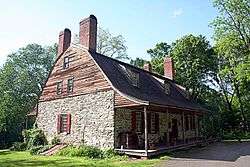
In 1780 Steuben sat on the court-martial of the British Army officer Major John André, captured and charged with espionage in conjunction with the defection of General Benedict Arnold.[4]:289 He later traveled with Nathanael Greene, the new commander of the Southern campaign.[4]:344–345 He quartered in Virginia, since U.S. supplies and soldiers would be provided to the army from there. Steuben would help in the defense of Virginia with approximately 1,000 militia fighting a delaying action in the Battle of Blandford. During the spring of 1781, he aided Greene in the campaign in the South, culminating in the delivery of 450 Virginia Continentals to Lafayette in June.[24]
He was forced to take sick leave, rejoining the army for the final campaign at Yorktown, where his role was as commander of one of the three divisions of Washington's troops. In 1783, General Von Steuben joined General Knox at Vail's Gate, near West Point, in the fall of 1782 and in early 1783 moved to the Verplanck homestead, at Mount Gulian, across the Hudson River from Washington's headquarters in Newburgh.[14] Steuben gave assistance to Washington in demobilizing the army in 1783[25] as well as aiding in the defense plan of the new nation. In May 1783, Steuben presided over the founding of the Society of the Cincinnati.[14] He was discharged from the military with honor on March 24, 1784.[8]
Final years
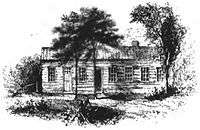
Steuben became a U.S. citizen by act of the Pennsylvania legislature in March 1784 (and later by the New York authorities in July 1786). With the war over, Steuben resigned from service and first settled with his longtime companion, William North, for whom he created a special room at his retreat he called the Louvre[27] on Manhattan Island, where he became a prominent figure and elder in the German Reformed Church. From 1785 until his death in 1794, he served as president of the German Society of the City of New York, a charitable society founded in 1784 to assist German immigrants.[28]
In 1786 during Shays' Rebellion, under the written name "Bellisarius", Steuben made suggestions of an oligarchy in the Massachusetts government.[29]
On December 23, 1783, the state of New Jersey presented him with the use of an estate in Bergen County now known as Steuben House,[30] which had been confiscated from Loyalist Jan Zabriskie in 1781. Located in the formerly strategic New Bridge Landing, the estate included a gristmill and about 40 acres (16 ha) of land. Legislators initially conditioned the grant, requiring Steuben to "hold, occupy and enjoy the said estate in person, and not by tenant." Gen. Philemon Dickinson of the New Jersey Militia informed the baron of this gift and responded to his inquiries that "there are on the premises an exceeding good House, an excellent barn, together with many useful outbuildings, all of which I am told, want some repairs...there is...a Grist-mill; a good Orchard, some meadow Ground, & plenty of Wood. The distance from N York by land 15 miles, but you may keep a boat & go from your own door to N York by water—Oysters, Fish & wild fowl in abundance—Possession will be given to you in the Spring, when you will take a view of the premises."[31] Von Steuben spent considerable sums to repair wartime damages to the house and restore its commercial operations under former aide Walker.
On September 5, 1788, the New Jersey Legislature gave Baron von Steuben full title to the former Zabriskie estate. A month later, recognizing his financial embarrassment, Steuben wrote another former aide-de-camp and companion, William North, recognizing: "The Jersey Estate must and is to be sold. Walker is my administrator, all debts are to be paid out of it." On November 6, 1788, Steuben again wrote North (at his new home in Duanesburg, New York), noting "My Jersey Estate is Advertised but not yet Sold, from this Walker Shall immediately pay to you the money, you so generously lend me and all my debts in New-York will be payed. I support my present poverty with more heroism than I Expected. All Clubs and parties are renounced, I seldom leave the House."[32] Steuben eventually sold the New Jersey property to a son of the previous owner, and it remained in the Zabriskie family until 1909. It is the only remaining eighteenth-century building that von Steuben owned.
Von Steuben was present at the first inauguration of George Washington in New York in 1789.[33]
Von Steuben moved upstate and settled in Oneida County on a small estate in the vicinity of Rome, New York, on land granted to him for his military service and where he had spent summers. He was later appointed a regent for what evolved into the University of the State of New York. In 1790, Congress awarded him a pension of $2,500 a year, which he kept until his death. [34]
Personal life and death
Von Steuben died on November 28, 1794, at his estate in Oneida County,[35] and was buried in a grove at what became the Steuben Memorial State Historic Site.[36] The estate became part of the town of Steuben, New York, which was named for him.
Von Steuben had arrived in the United States with his 17-year-old secretary, Peter Stephen Du Ponceau.[37] At Valley Forge, he began close relationships with Benjamin Walker and William North, then both military officers in their 20s.[38] Von Steuben formally adopted Walker and North and made them his heirs.[39] Some historians believe that these "extraordinary intense emotional relationships"[40] were romantic,[41] and, given Steuben's reported earlier behaviour, it has been suggested it would have been out-of-character for him if they were not.[42] However, based on the limited historical record, it is impossible to prove.[43] Because homosexuality was criminalized at the time, records of his relationships are limited to references in correspondences.
In any case, von Steuben never married and had no children. He did not care much for his European relatives.[4] Thus, he left his estate to his companions and aides-de-camp, Captain Benjamin Walker and Major General William North, with whom he had had an "extraordinarily intense emotional relationship ... treating them as surrogate sons."[44] A third young man, John W. Mulligan (1774–1862), also considered himself one of Steuben's "sons"; he inherited Von Steuben's vast library, collection of maps and $2,500 in cash.[45] Following Baron Steuben's death, North divided the property bequeathed to him among his military companions.[46]
Legacy
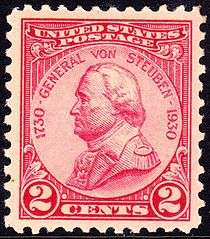
Generally, Von Steuben Day takes place in September in many cities throughout the United States. It is often considered the German-American event of the year. Participants march, dance, wear German costumes and play German music, and the event is attended by millions of people. The German-American Steuben Parade is held annually in September in New York City. It is one of the largest parades in the city and is traditionally followed by an Oktoberfest in Central Park as well as celebrations in Yorkville, Manhattan, a historically German section of New York City. The German-American Steuben Parade has been taking place since 1958.[47] Chicago also hosts a von Steuben Day parade, which is featured in the U.S. film Ferris Bueller's Day Off.[48] Philadelphia hosts a smaller Steuben Parade in the Northeast section of the city.[49]
The Steuben Society was founded in 1919 as "an educational, fraternal, and patriotic organization of American citizens of German background". In the difficult post-World War I years the Society helped the German-American community to reorganize. It is now one of the largest organizations for Americans of German descent.[50]
A warship, a submarine, and an ocean liner (later pressed into military service) were named in von Steuben's honor. In World War I the captured German ship SS Kronprinz Wilhelm was renamed as USS Von Steuben,[51] and in World War II there was the Dampfschiff General von Steuben, an ill-fated German luxury passenger ship which was turned into an armed transport ship during the war.[52] During the Cold War, the U.S. Navy submarine USS Von Steuben was named for him.[53]
Several locations in the United States are also named Steuben, most of them in his honor. Examples include Steuben County, New York,[54] Steuben County, Indiana,[55] and the city of Steubenville, Ohio.[56] Several buildings are named for Steuben, among them Von Steuben Metropolitan High School in Chicago, Illinois,[57] as well as one of the cadet barracks buildings at Valley Forge Military Academy and College.[58]
Von Steuben was one of four European military leaders who assisted the U.S. cause during the Revolution and was honored with a statue in Lafayette Square, just north of the White House, in Washington, D.C. The statue by Albert Jaegers was dedicated in 1910.[59] A copy was dedicated in Potsdam, Germany in 1911, and destroyed during World War II. A new cast was given in honor of German-American friendship in 1987, and to celebrate the 750th anniversary of the founding of Berlin. It was installed in the Dahlem district, in what had been the U.S. sector of the formerly divided city.[60] An additional cast is in Steuben's home town of Magdeburg.[61] Statues of Steuben by J. Otto Schweizer can be found in Valley Forge, Pennsylvania, and Utica, New York,[62] in addition to an equestrian statue by Schweizer in Milwaukee, Wisconsin.[63] A bust of Steuben is in the garden of the German Embassy in Washington, D.C.[62]
The Steuben House, presented to Steuben as a gift for his services in the Continental Army, is located at New Bridge Landing in River Edge, New Jersey. The house and surrounding farmland were seized in 1781 from a Loyalist family. The house looks much as it did after Steuben renovated it. The State of New Jersey took possession of the historic mansion and one acre of ground for $9,000 on June 27, 1928. It was opened as a public museum in September 1939. The Bergen County Historical Society opens the building for special events. It is under the jurisdiction of the Historic New Bridge Landing Park Commission.[64]
Other tributes include Steuben Field, the stadium of the Hamilton College football team.[65] Von Steuben, acting as Alexander Hamilton's surrogate, laid the cornerstone of the school.[66]
The various depictions of Steuben in popular U.S. media include portrayals by Nehemiah Persoff in the 1979 U.S. TV miniseries The Rebels,[67] Kurt Knudson in the 1984 TV miniseries George Washington,[68] being voiced by Austrian-American Arnold Schwarzenegger in the animated series Liberty's Kids,[69] and by David Cross on the "Philadelphia" episode of Drunk History.[70]
In 2007, a popular documentary DVD was released by LionHeart FilmWorks and director Kevin Hershberger titled Von Steuben's Continentals: The First American Army. The 60-minute, live-action documentary details the life, uniforms, camp life, food, weapons, equipment and drill of the Continental soldier 1775–1781, as taught and developed by Baron von Steuben.[71]
 Steuben House, River Edge, New Jersey. A gift to Steuben from the State of New Jersey, this is the only extant house he owned.
Steuben House, River Edge, New Jersey. A gift to Steuben from the State of New Jersey, this is the only extant house he owned.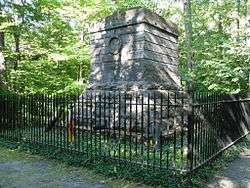
- Steuben Monument (1910), Albert Jaegers, sculptor, Lafayette Park, Washington, D.C. There are copies in Germany, at Berlin-Dahlem, Magdeburg and Potsdam
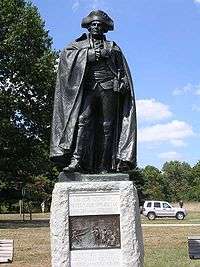 Baron von Steuben (1915), J. Otto Schweizer, sculptor, Valley Forge National Historical Park, Pennsylvania. A copy is in Utica, New York.
Baron von Steuben (1915), J. Otto Schweizer, sculptor, Valley Forge National Historical Park, Pennsylvania. A copy is in Utica, New York. General von Steuben Drilling Washington's Army at Valley Forge (1915), J. Otto Schweizer, sculptor. Bas-relief panel on the base of the Valley Forge statue.
General von Steuben Drilling Washington's Army at Valley Forge (1915), J. Otto Schweizer, sculptor. Bas-relief panel on the base of the Valley Forge statue.
References
- Stephen C. Danckert, "Baron von Steuben and the Training of Armies." Military Review 74 (1994): 29-34 in EBSCO
- Fleming, Thomas (February–March 2006). "The Magnificent Fraud". American Heritage.
- "Friedrich Wilhelm von Steuben". Bergen County Historical Society. Archived from the original on November 16, 2014.
- Kapp, Friedrich (1859). Life of Frederick William Von Steuben: Major General in the Revolutionary Army. Mason Brothers. p. 54.
- Thacher, James (1827). A Military Journal During the American Revolutionary War: From 1775 to 1783. Cottons & Barnard. p. 420. Retrieved February 26, 2018.
- Kapp 1859, p. 45.
- "General von Steuben". Valley Forge (National Historical Park Pennsylvania). National Park Service. Archived from the original on February 10, 2015. Retrieved October 9, 2016.
- Bielakowski, Alexander M. (2013). Ethnic and Racial Minorities in the U.S. Military: An Encyclopedia. ABC-CLIO. pp. 667–69. Archived from the original on January 14, 2016.
- Lockhart, Paul (June 27, 2008). "The Rich Legacy of a Forgotten Founder". US News and World Report. Archived from the original on September 8, 2015.
- "Major General Von Steuben". Steuben Society of America. 2014. Archived from the original on January 16, 2016. Retrieved October 9, 2016.
- Villa, Pablo (September 18, 2015). "Friedrich von Steuben: A Closer Look at the 'Father' of the NCO Corps". NCO Journal. Archived from the original on August 9, 2016.
- Shilts, Randy (2005). Conduct Unbecoming: Gays and Lesbians in the U.S. Military. St. Martin's Press. pp. 7–10. Archived from the original on May 9, 2016.
- Adam, Thomas (2005). Germany and the Americas: Culture, Politics, and History; a Multidisciplinary Encyclopedia. ABC-CLIO. p. 1007. Archived from the original on January 14, 2016.
- "General Von Steuben". Mount Gulian Historic site. Archived from the original on May 2, 2015.
- Deats, Paula; Fleisher, Carol L. (1995). "A War Without End" episode". The Revolutionary War. The Learning Channel.
- Benemann, William E. (2006). Male–Male Intimacy in Early America: Beyond Romantic Friendships (1st ed.). New York: Routledge.
- Kapp 1859, p. 228-229.
- Kapp 1859, p. 157-158.
- "Drill and Ceremony #43". ArmyStudyGuide.com. Archived from the original on March 2, 2009. Retrieved April 9, 2009.
- The current revision of this book is available for download from the US Army directly The United States Army
- Lockhart, Paul Douglas (2008). The Drillmaster of Valley Forge: The Baron de Steuben and the Making of the American Army. New York: HarperCollins. ISBN 0-06-145163-0.
- Washington, George (May 2, 1779). "General Orders, 2 May 1779". Founders Online, National Archives. Notes.
- Greiff, Constance M. (December 4, 2002). "NRHP Nomination: Staats House". National Park Service. Cite journal requires
|journal=(help) - Greene, Franics Vinton (1911). The Revolutionary War and the Military Policy of the United States. New York Public Library. p. 262.
- "Baron Von Steuben". Museum Collections. National Park Service. Archived from the original on November 13, 2012.
- Headley, Joel Tyler (1900). . In Wilson, J. G.; Fiske, J. (eds.). Appletons' Cyclopædia of American Biography. New York: D. Appleton.
- Von Zemenszky, Edith (1982). The Papers of General Friedrich Wilhelm von Steuben 1777–1794. Millwood, NY. Account with -------, reel 6, frame.
- Wust, Klaus (1984). Guardian on the Hudson: The German Society of the City of New York, 1784–1984. New York: The Society. ISBN 0-917968-11-5. p. 15-16.
- Richards, Leonard L (2002). Shays's Rebellion: The American Revolution's Final Battle. Philadelphia: University of Pennsylvania Press. ISBN 978-0-8122-1870-1. OCLC 56029217. pp. 15-16
- "Zabriskie-Steuben House". Bergen County Historical Society. Archived from the original on January 3, 2007.
- Karels, Carol (2007). The Revolutionary War in Bergen County. Charleston, SC: The History Press. p. 61. ISBN 9781596293588.
- Quoted in: Wright, Kevin. "Baron von Steuben's Jersey Estate at New Bridge Archived October 14, 2016, at the Wayback Machine". Bergen County Historical Society. Retrieved October 9, 2016.
- Kapp 1859, p. 585.
- https://www.ushistory.org/valleyforge/served/steuben.html
- "Frederick William Augustus von Steuben, Baron." Encyclopedia of World Biography. Detroit: Gale, 1998. Retrieved from Biography in Context database, October 9, 2016.
- Wilson, Scott. Resting Places: The Burial Sites of More Than 14,000 Famous Persons, 3d ed.: 2 (Kindle Location 44998). McFarland & Company, Inc., Publishers. Kindle Edition.
- Unknown (February 3, 2016). "General Von Steuben". www.nps.gov. National Park Service. Retrieved December 10, 2018.
- Benemann, William E. (2014). Male-Male Intimacy in Early America: Beyond Romantic Friendships. Routledge. p. 102. ISBN 9781317953463.
- Kapp, Friedrich The Life of Frederick William Von Steuben, Major General in the United States Army, Mason Brothers, New York 1859, p. 707.
- American National Biography - Volume 16 - Page 513. n.b. Contrary to many online articles, this phrase does not appear in Steuben's final Will: http://loyolanotredamelib.org/php/report05/articles/pdfs/Report35Pritchett19-26.pdf
- Benemann, William Male-Male Intimacy in Early America: Beyond Romantic Friendships Haworth Press, 2006, ISBN 1-56023-345-1
- Quinn, Michael D. Same-Sex Dynamics among Nineteenth-Century Americans, University of Illinois Press, 2001, pp179-180
- Benemann, p. 102
- Skelton, William B. (February 2000). "North, William". American National Biography Online.
- "Steuben and John W. Mulligan, Jr". Archived from the original on January 2, 2018. Retrieved January 1, 2018.
- White, J.T. (1892). The National Cyclopaedia of American Biography. Harvard University. p. 7.
- "German-American Steuben Parade of New York". Archived from the original on June 8, 2007.
- Swartz, Tracy (June 5, 2015). "Ferris Bueller took his day off 30 years ago today". Chicago Tribune. Archived from the original on December 10, 2017. Retrieved February 2, 2018.
- "German – American Parade Philadelphia". Steuben Day Observance Association of Philadelphia and Vicinity. Archived from the original on September 22, 2017. Retrieved February 21, 2018.
- "Our History Archived October 11, 2016, at the Wayback Machine". The Steuben Society of America. www.steubensociety.org. Retrieved October 9, 2016.
- "Von Steuben I (Id. No. 3017)". Dictionary of American Naval Fighting Ships. Navy Department, Naval History and Heritage Command.
- Grooss, Poul (April 30, 2017). The Naval War in the Baltic 1939 -1945. Seaforth Publishing. p. 473. ISBN 9781526700025. Retrieved February 23, 2018.
- "VON STEUBEN". Dictionary of American Naval Fighting Ships. Navy Department, Naval History and Heritage Command.
- Sherer, Richard G. "A Brief History". Steuben County, New York. Archived from the original on December 21, 2016. Retrieved February 21, 2018.
- "Steuben County History". Steuben County, Indiana. Archived from the original on June 8, 2017. Retrieved February 21, 2018.
- "Historic Fort Steuben". Archived from the original on February 1, 2011.
- "Von Steuben HS". Chicago Public Schools. Archived from the original on September 29, 2017. Retrieved February 21, 2018.
- "Cadet Life". Valley Forge Military Academy & College. Archived from the original on February 22, 2018. Retrieved February 21, 2018.
- "Honor Steuben Today." Washington Post. December 7, 1910.
- Salzmann, Dieter. "Die Geschichte der Steubenparade in New York – in Erinnerung an Baron Steuben". www.steubenparade.de (in German). Archived from the original on March 17, 2017. Retrieved February 21, 2018.
- "Friedrich von Steuben Memorial, Magdeburg". German Information Center USA. German National Tourist Board. Archived from the original on February 22, 2018. Retrieved February 21, 2018.
- Pohlsander, Hans A. (2010). German Monuments in the Americas: Bonds Across the Atlantic. Peter Lang. pp. 28–33. ISBN 9783034301381. Retrieved February 21, 2018.
- Buck, Diane (1995). Outdoor Sculpture in Milwaukee. Madison: Wisconsin Historical Society. pp. 154–156. ISBN 978-0-87020-276-6.
- "Bergen County Historical Society". Archived from the original on May 9, 2008.
- "NESCAC Football Record Book". Archived from the original on November 29, 2006.
- "Memorial stone for Hamilton-Oneida Academy building". Hamilton College. Archived from the original on October 21, 2016. Retrieved February 21, 2018.
- The Rebels on IMDb
- George Washington on IMDb
- Friedrich Wilhelm von Steuben on IMDb
- "Drunk History – Philadelphia". Comedy Central. Archived from the original on August 2, 2017. Retrieved February 21, 2018.
- "LionHeart FilmWorks". Archived from the original on February 28, 2010.
Sources
- Palmer, John McAuley (1937). General Von Steuben. Yale University Press.CS1 maint: ref=harv (link)
- Danckert, Stephen C. "Baron von Steuben and the Training of Armies." Military Review 74 (1994): 29-34 in EBSCO
- Steuben Papers, NYHS
- The Historic Society of Pennsylvania, Simon Gratz Collection (#250), Case 4, Box 13 William North /Benjamin Walker Letters
- Guide to the Friedrich Wilhelm von Steuben Papers at the New-York Historical Society
Further reading
- Doyle, Joseph Beatty. Frederick William Von Steuben and the American Revolution: Aide to Washington and Inspector General of the Army (1913).
- Palmer, John MacAuley. General von Steuben (Yale UP, 1937).
- Whitridge, Arnold. "Baron von Steuben, Washington's Drillmaster." History Today (July 1976) 26#7 pp 429–36.
External links
| Wikimedia Commons has media related to Friedrich Wilhelm von Steuben. |
| Wikisource has original works written by or about: Friedrich Wilhelm von Steuben |
- Works by or about Friedrich Wilhelm von Steuben at Internet Archive
- Works by Friedrich Wilhelm von Steuben at LibriVox (public domain audiobooks)

- Bowen, Francis; Hayward, Charles (1838). Lives of Baron Steuben, Sebastian Cabot, and William Eaton.
- Friedrich Wilhelm Ludolf Gerhard Augustin Baron von Steuben. Baron Von Steuben's Revolutionary War Drill Manual
- Baron Von Steuben: An account of a 19th century visit to America by his German relatives
- N.Y. Times: Steuben hosted by the Nation he helped to create
- Newspaper clippings about Friedrich Wilhelm von Steuben in the 20th Century Press Archives of the ZBW
| Military offices | ||
|---|---|---|
| Preceded by Thomas Conway |
Inspector General of the U.S. Army May 5, 1778 – April 15, 1784 |
Succeeded by William North |